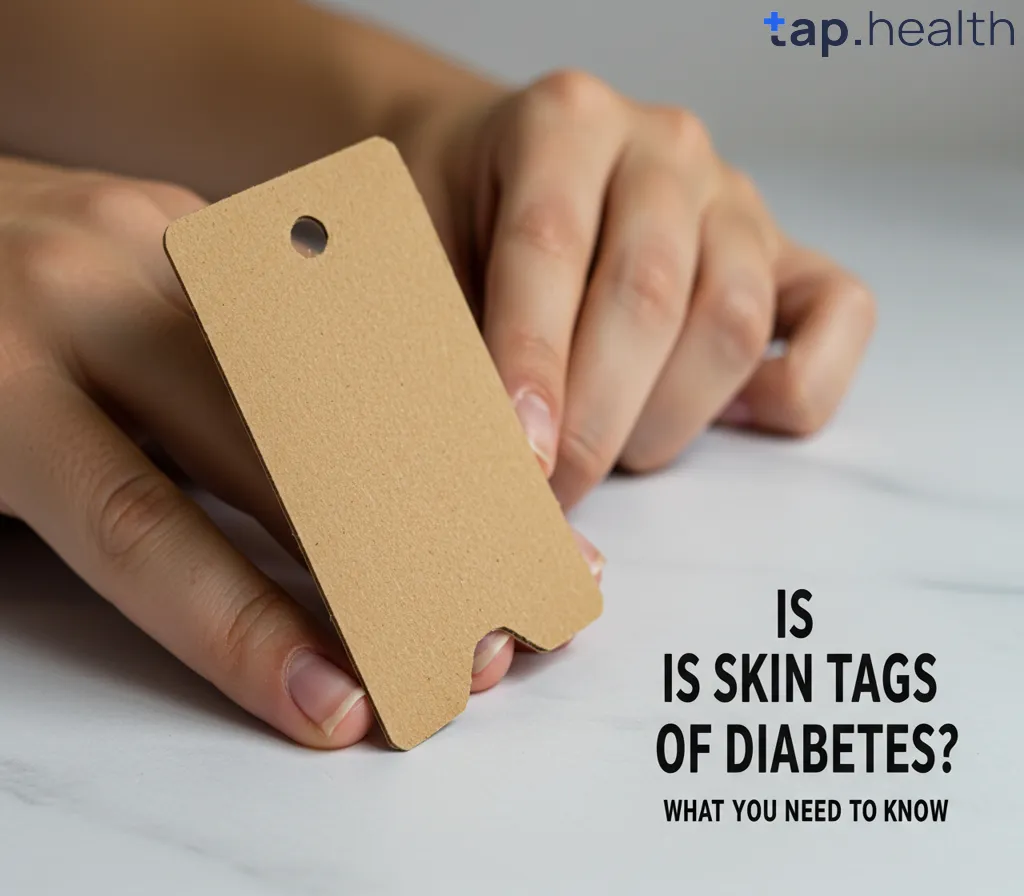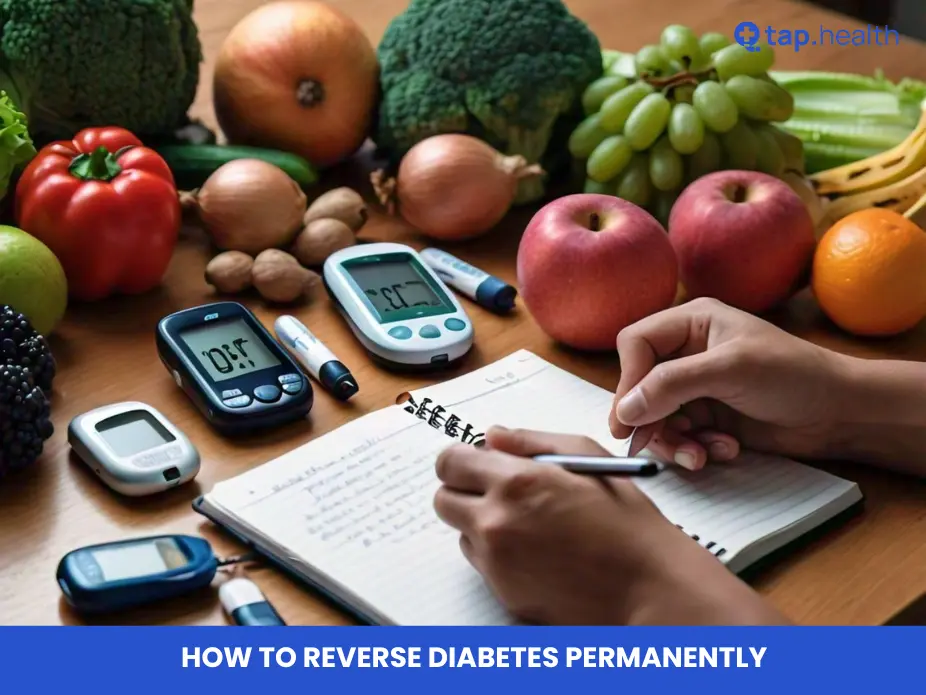You’ve probably noticed them — those tiny, soft flaps of skin that pop up on your neck, underarms, or eyelids. They’re called skin tags, and they’re super common.
But if you’ve started seeing more of them lately, you might be asking: Is skin tags a sign of diabetes?
The short answer: Skin tags alone don’t mean you have diabetes — but having lots of them can be a clue that your blood sugar isn’t where it should be.
In this article, we’ll break down everything you need to know in plain, simple language — no confusing medical terms. We’ll cover:
- What skin tags are and why they form
- The real connection between skin tags and diabetes
- Other skin signs of high blood sugar
- When to talk to your doctor
- How to prevent and treat skin tags
We’ve researched this using top health sources like the American Diabetes Association (ADA), Mayo Clinic, Cleveland Clinic, Johns Hopkins Medicine, and the National Institute of Diabetes and Digestive and Kidney Diseases (NIDDK).
Let’s get into it.
What Are Skin Tags?
First, let’s understand what skin tags actually are.
Small, Harmless, and Very Common
A skin tag is a tiny piece of skin that sticks out from the surface. It’s usually:
- Soft and smooth
- The same color as your skin or slightly darker
- Attached by a thin stalk (called a peduncle)
- About the size of a grain of rice (but can grow larger)
They don’t hurt, itch, or bleed — unless you rub or pull on them.
Where Do Skin Tags Appear?
Skin tags love areas where skin rubs against skin or clothing. Common spots include:
- Neck
- Underarms
- Eyelids
- Groin
- Under the breasts
- Belly folds
They’re not dangerous — just annoying.
Who Gets Skin Tags?
Almost half of all adults will get at least one skin tag in their life.
They’re more common in:
- People over 40
- Pregnant women
- Those who are overweight or obese
- People with a family history of skin tags
And — as we’ll explain — people with insulin resistance or type 2 diabetes.
Is Skin Tags a Sign of Diabetes? The Real Connection
Now, the big question: Is skin tags a sign of diabetes?
The answer isn’t a simple yes or no. Let’s break it down.
Skin Tags Don’t Cause Diabetes — But They Can Be a Warning Sign
You don’t get diabetes because of skin tags.
But if you have many skin tags, especially in clusters, it might mean your body is struggling with insulin resistance — a major step toward type 2 diabetes.
Think of skin tags like a red flag: “Hey, something might be off with your blood sugar.”
Why Do People with Diabetes Get More Skin Tags?
It comes down to two main things: insulin resistance and high insulin levels.
1. Insulin Resistance Explained
In type 2 diabetes, your body makes insulin — but your cells don’t respond to it well. This is called insulin resistance.
To make up for it, your pancreas pumps out more insulin.
High insulin levels can overstimulate skin cells, especially in areas where skin rubs together.
This may lead to extra skin growth — like skin tags.
2. Insulin Triggers Skin Cell Growth
Insulin isn’t just for blood sugar. It also acts like a growth signal in the body.
When insulin levels stay high for a long time (like in prediabetes or early diabetes), it can cause:
- Thickening of the skin
- Dark patches (called acanthosis nigricans)
- Skin tags
So, while skin tags aren’t caused by diabetes, they’re often seen in people who have it — or are on their way to developing it.
What Do Studies Say About Skin Tags and Diabetes?
Science backs up the link.
Multiple Studies Show a Strong Connection
A 2010 study published in the Journal of the European Academy of Dermatology and Venereology found that:
- People with multiple skin tags were more likely to have:
- High blood sugar
- Insulin resistance
- High cholesterol
- High blood pressure
Another study in Diabetes Care showed that patients with 10 or more skin tags had a much higher risk of undiagnosed type 2 diabetes.
Skin Tags as a “Soft Sign” of Metabolic Syndrome
Doctors sometimes call skin tags a “soft sign” of metabolic syndrome — a group of conditions that include:
- High blood pressure
- High blood sugar
- Excess belly fat
- Abnormal cholesterol
Having metabolic syndrome greatly increases your risk of diabetes and heart disease.
So, if you have lots of skin tags, your doctor might check for these other issues.
How Many Skin Tags Are “Too Many”?
One or two skin tags? Totally normal.
But when should you start wondering if it’s more than just a skin thing?
The Rule of Thumb: 5 or More = Worth a Checkup
If you have:
- 5 or more skin tags
- Especially in clusters (like several on your neck)
- Or if they’re growing fast
…it’s a good idea to talk to your doctor — especially if you have other risk factors for diabetes.
More skin tags = stronger the link to insulin problems.
Other Skin Signs of Diabetes
Skin tags aren’t the only skin clue that your blood sugar might be high.
Here are other common skin conditions linked to diabetes.
1. Acanthosis Nigricans: Dark, Velvety Patches
This is one of the strongest skin signs of insulin resistance.
- Looks like dark, thick, velvety skin
- Usually on the back of the neck, armpits, or groin
- Feels rough or dirty (but scrubbing won’t help)
It’s often seen in people who are overweight and have prediabetes.
If you see this, it’s a very strong signal to get your blood sugar checked.
2. Diabetic Dermopathy: Light Brown Spots
These are harmless but common in people with long-term diabetes.
- Look like small, round, light brown spots
- Often on the shins
- Sometimes called “shin spots”
They don’t hurt and usually fade over time.
3. Fungal Infections (Like Yeast Infections)
High blood sugar creates a sweet environment — perfect for yeast and fungus to grow.
Common signs:
- Itchy, red rashes in skin folds
- White discharge (in genital area)
- Cracked skin in corners of the mouth (called angular cheilitis)
These infections can be a clue that blood sugar is high.
4. Itchy Skin (Pruritus)
Dry, itchy skin can be caused by:
- Poor circulation
- High blood sugar
- Kidney problems (a diabetes complication)
If your skin is itchy all the time — especially your legs — it’s worth checking.
5. Skin Infections That Won’t Heal
High blood sugar weakens the immune system.
This can lead to:
- Boils
- Styes
- Slow-healing cuts
- Frequent abscesses
If small wounds take forever to heal, it could be a sign of diabetes.
What Causes Skin Tags Besides Diabetes?
Just because you have skin tags doesn’t mean you have diabetes.
Many other things can cause them.
1. Friction (Skin Rubbing on Skin)
This is the most common cause.
If your skin folds rub together — like under the arms or belly — it can trigger skin tag growth.
Overweight people are more likely to have this, but anyone can get them.
2. Hormonal Changes
Pregnancy and aging can cause skin tags due to hormone shifts.
Growth hormones and insulin-like hormones may play a role.
3. Genetics
If your parents had lots of skin tags, you’re more likely to get them too.
It’s just how your body responds to friction and hormones.
4. Human Papillomavirus (HPV)
Some studies suggest a link between certain types of HPV (the virus that causes warts) and skin tags.
But this is still being studied — and skin tags are not contagious.
When Should You See a Doctor About Skin Tags?
Most skin tags don’t need treatment — but there are times you should see a doctor.
See a Doctor If You Have:
✅ Many skin tags (5 or more)
✅ Rapid growth (new ones appearing quickly)
✅ Large or painful skin tags
✅ Bleeding, itching, or changing color
✅ Dark patches on your neck or armpits (acanthosis nigricans)
These could be signs of insulin resistance or undiagnosed diabetes.
What Tests Might Your Doctor Order?
If your doctor suspects diabetes, they might order:
- Fasting blood glucose test – Checks blood sugar after not eating
- HbA1c test – Shows average blood sugar over 2–3 months
- Oral glucose tolerance test – Measures how your body handles sugar
These tests can tell if you have:
- Normal blood sugar
- Prediabetes
- Type 2 diabetes
Early detection means you can take action — like changing your diet or losing weight — to prevent or delay diabetes.
Can Removing Skin Tags Cure or Prevent Diabetes?
No — removing skin tags won’t cure or prevent diabetes.
Skin tag removal is purely cosmetic or comfort-based.
Why People Remove Skin Tags
- They catch on clothing or jewelry
- They’re in a visible area (like the face)
- They’re embarrassing
Common Removal Methods
| Snipping | Doctor cuts it off with sterile scissors | Yes, if done by a pro |
| Freezing (Cryotherapy) | Uses liquid nitrogen to freeze it off | Safe, may take a few tries |
| Burning (Electrocautery) | Burns it off with electric current | Safe, done in clinics |
| Tying with Thread | Cuts off blood supply | Risky — can cause infection |
| Over-the-counter kits | Patches or bands | Use with caution |
Never try to cut or burn off a skin tag at home. You could cause infection or scarring.
See a dermatologist or primary care doctor instead.
How to Reduce Your Risk of Diabetes (Even If You Have Skin Tags)
If you have skin tags and are worried about diabetes, here’s the good news: you can lower your risk.
1. Lose Weight (Even a Little)
Losing just 5–10% of your body weight can:
- Improve insulin sensitivity
- Lower blood sugar
- Reduce skin tags over time
Example: If you weigh 200 lbs, losing 10–20 lbs makes a big difference.
2. Eat a Balanced Diet
Focus on:
- Whole grains (brown rice, oats)
- Vegetables and fruits (not juice)
- Lean proteins (chicken, fish, beans)
- Healthy fats (avocado, nuts, olive oil)
Avoid:
- Sugary drinks (soda, sweet tea)
- Processed snacks (chips, cookies)
- White bread and white rice
3. Move Your Body Every Day
You don’t need to run a marathon.
Just 30 minutes of walking most days can:
- Lower blood sugar
- Help with weight loss
- Improve insulin response
Other great options: dancing, swimming, biking, gardening.
4. Get Regular Checkups
Even if you feel fine, get your:
- Blood pressure
- Cholesterol
- Blood sugar
Checked yearly — especially if you’re over 40 or have a family history of diabetes.
5. Quit Smoking and Limit Alcohol
Smoking increases insulin resistance.
Too much alcohol can raise blood sugar and lead to weight gain.
Both make diabetes risk worse.
Are Skin Tags Dangerous?
No — skin tags are not dangerous.
They are:
- Not cancerous
- Not contagious
- Not a sign of infection (unless they get irritated)
But if a skin tag:
- Bleeds a lot
- Changes color (turns black or purple)
- Grows very fast
- Hurts or itches
…see a doctor. It might not be a skin tag — it could be something else, like a mole or cyst.
Can Skin Tags Go Away on Their Own?
Most skin tags won’t go away on their own.
Once they form, they usually stay unless removed.
But:
- Some may dry up and fall off if the blood supply is cut
- Losing weight and improving insulin levels may prevent new ones
- Treating underlying diabetes may reduce future growth
So, while existing tags won’t vanish, you can stop new ones from forming.
What’s the Difference Between Skin Tags and Warts?
They look similar — but they’re different.
| Cause | Friction, insulin, hormones | HPV virus |
| Contagious? | No | Yes |
| Texture | Soft, smooth | Rough, bumpy |
| Color | Skin-toned or brown | Gray or yellow |
| Pain? | No (unless irritated) | Sometimes |
| Treatment | Snip, freeze, burn | Salicylic acid, freezing, immune boosters |
If you’re not sure, see a doctor for a proper diagnosis.
Can Children Get Skin Tags?
Yes — but it’s less common.
Kids who get skin tags often:
- Are overweight
- Have a family history
- Show early signs of insulin resistance
If a child has many skin tags or dark neck patches, it’s worth checking blood sugar — especially if there’s a family history of type 2 diabetes.
Childhood obesity is rising — and so is childhood type 2 diabetes.
Early action can make a big difference.
Is There a Link Between Skin Tags and PCOS?
Yes — and it’s important.
Polycystic Ovary Syndrome (PCOS) is a hormonal disorder in women that:
- Causes irregular periods
- Leads to weight gain
- Increases insulin resistance
Because of the insulin link, women with PCOS often get:
- Skin tags
- Acanthosis nigricans
- Acne
- Excess hair
So, if a woman has skin tags and irregular periods, PCOS could be the cause — not just diabetes.
A doctor can test for both.
Final Verdict: Is Skin Tags a Sign of Diabetes?
Yes — skin tags can be a sign of diabetes, but only when they appear in large numbers or with other symptoms.
Having one or two skin tags? Totally normal.
But if you have:
- Many skin tags
- Dark, velvety skin patches
- Weight gain around the belly
- High blood pressure or cholesterol
…it’s time to talk to your doctor.
Skin tags aren’t a diagnosis — but they can be a wake-up call to check your blood sugar and make healthy changes.
The good news? Even if you’re on the path to diabetes, you can turn it around with diet, exercise, and medical care.
And removing skin tags? That’s easy — but fixing what’s underneath? That’s what really matters.
Frequently Asked Questions (FAQ) on Is Skin Tags a Sign of Diabetes?
Q: Is skin tags a sign of diabetes?
A: Not always — but having many skin tags can be a clue of insulin resistance or prediabetes. It’s a warning sign, not a diagnosis.
Q: How many skin tags indicate diabetes?
A: There’s no exact number, but having 5 or more, especially on the neck or armpits, increases the chance of insulin problems.
Q: Can skin tags go away if you control diabetes?
A: Existing tags won’t disappear, but managing blood sugar may prevent new ones from forming.
Q: What does a diabetic skin tag look like?
A: It looks the same as any skin tag — small, soft, and flesh-colored. The concern is the number and location, not the appearance.
Q: Are skin tags dangerous?
A: No. Skin tags are harmless. But see a doctor if they bleed, hurt, or change color.
Q: Can skin tags be a sign of cancer?
A: No. Skin tags are not cancerous and don’t turn into cancer.
Q: What’s the difference between a skin tag and a wart?
A: Skin tags are soft and caused by friction or hormones. Warts are rough, caused by a virus (HPV), and can spread.
Q: Can losing weight reduce skin tags?
A: Yes. Weight loss improves insulin sensitivity, which may reduce new skin tag growth.
Q: Should I get my blood sugar checked if I have skin tags?
A: Yes — especially if you have many skin tags, dark neck patches, or other risk factors like obesity or family history.
Q: Can children with skin tags have diabetes?
A: It’s rare, but possible — especially if the child is overweight or has PCOS. Talk to a pediatrician.
Q: Do skin tags mean I have high insulin?
A: Not for sure — but high insulin (from insulin resistance) is a common cause of multiple skin tags.
Q: Can skin tags come back after removal?
A: Yes. Removing one doesn’t stop new ones from forming — especially if insulin levels stay high.
Q: Is there a blood test for skin tags?
A: No — but your doctor may order blood tests for blood sugar, insulin, and cholesterol if you have many skin tags.
Q: Can skin tags be prevented?
A: You can’t prevent them completely, but maintaining a healthy weight, controlling blood sugar, and reducing skin friction may help.
Q: Where can I get skin tags removed?
A: See a dermatologist, primary care doctor, or clinic. Don’t try to remove them at home.



